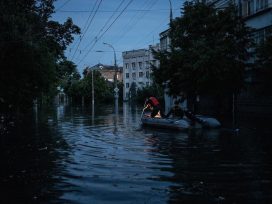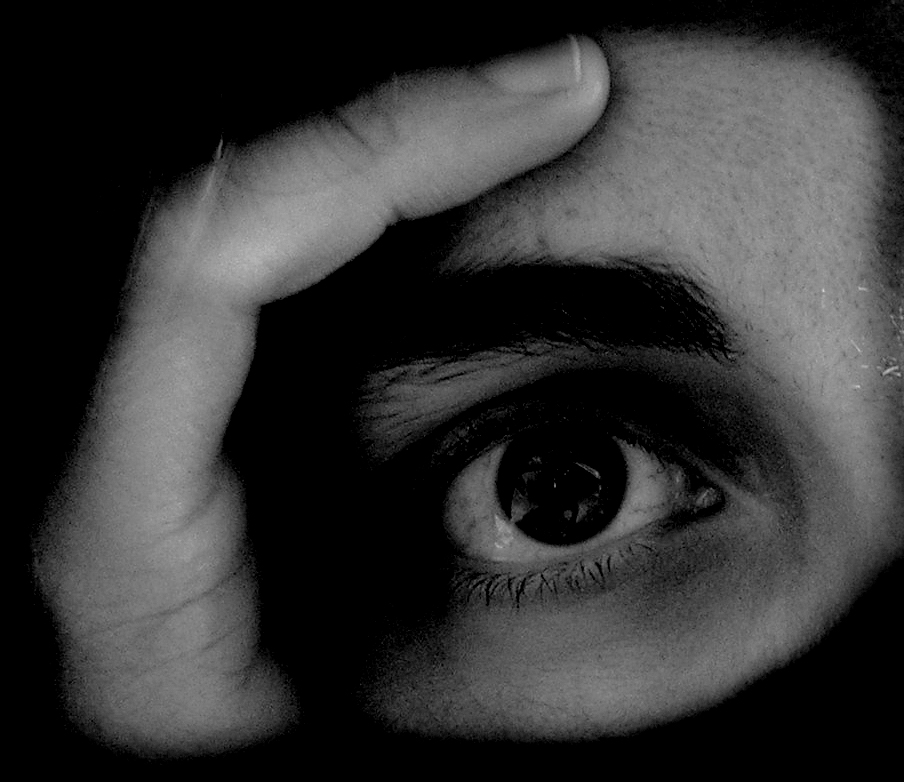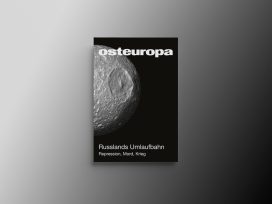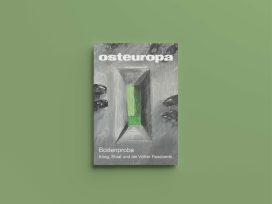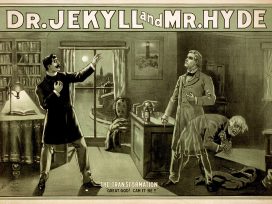On 1 April 2022, horrifying photos from Bucha, a small town outside Kyiv, spread throughout international media. Taken in the wake of a one-month occupation of the region of Ukraine by Russian armed forces, the photographs bore abundant testimony to a terrible massacre committed by the invaders. Many bodies of civilians, including women and children, were found dead, mutilated and burnt, with bound hands, featuring traces of tortures and rape. There were corpses everywhere on the streets and in the basements of buildings, but also in mass graves hastily dug by the soldiers in order to hide the evidence of their atrocities.
How did Russian state media react to these images? They called it a provocation and began to claim that Ukrainians had simply staged the killings and faked the footage in order to discredit Russia. On top of that, on 18 April, the 64th Separate Guards Motor Rifle Brigade, which was operating in Bucha, was awarded honorary guards status by President Putin. Society was forced to admit: yes, even in the 21st century, genocide, torture and mass murder are still possible. Moreover, those who commit these crimes can be celebrated as national heroes.
From the geopolitical perspective shared by many rightwingers, war is war, and everything can happen there. The state of exception associated with warfare normalises violence as a means justified by certain ends, such as the interests of sovereign states and alliances. From the moral point of view prevalent in liberal media, what happened in Bucha and other Ukrainian cities occupied by the Russian army is pure evil and has no rational explanation.
The general problem with evil, however, is that in the eyes of the one who judges, it always comes from the Other, in whose face they would never recognise their own. The syllogism of the moral consciousness – ‘I could never do that; other humans are people just like me; therefore, Bucha is not possible’ – breaks on the fact that it is not only possible, but actual and real. If Russian soldiers are people like me, how is it that they can torture non-combatants, kill children or rape women and then burn them?
The easiest solution would be to dehumanise the criminals and search for the roots of their pathological obsession with cruelty in the Russian national character or culture, which is stereotypically portrayed as celebrating violence. This brings us to another syllogism: ‘Others are human beings like me; Russian soldiers are not like me; therefore, they are not human beings.’
War and the death drive
Leaving behind both these popular perspectives – geopolitical cynicism, which justifies war crimes, on the one hand, and the liberal moral consciousness, which dehumanises their subjects, on the other – I suggest we take a different approach. To comprehend Bucha as reality, together with the conditions that made it possible, we have to admit that Bucha was not an exception, but merely one of the names for something that has reoccurred constantly throughout human history, regardless of the level of progress in this or that particular geographical area. Something that comes with war as one of its possible developments, but not necessarily reduced to it. Something that provides the most terrifying scenes in the theatre of war.
The theatre of war is a very precise term: it refers to a real situation where actions develop according to a certain scenario written by no one, with scenes of violence and death rehearsed and repeated beyond our volition. If war is a theatre, then Bucha is a scene – not in the sense implied by the Russian propaganda machine, which claimed that it was staged by the Ukrainian side, but in a much more radical sense. What happens when we look at the images of tortured and murdered people is a phantasmic encounter between the one who looks and what is looked at. There are scenes that provoke horror or repulsion, scenes that we would like to unsee, that we immediately tend to replace with something more acceptable.
The psychological mechanism of negation signals the contents that are being repressed. From a psychoanalytical perspective, these contents are extremely important for understanding the inner truth, the secret of a subject, their unconscious desires and drives. Bucha can be regarded as a distorted mirror, in which today’s humanity cannot recognise itself, curdled against its own frightening projection of the inhuman Other as a source of evil. The scene of Bucha displays – to borrow Slavoj Žižek’s definition – ‘the cause of the terror constitutive of our being‐human, the inhuman core of being‐human, the dimension of what the German Idealists called negativity and Freud called the death drive.’
The concept of the death drive (Todestrieb) was first introduced by Sabina Spielrein, a Russian physician and psychoanalyst who was killed by the Nazis in Rostov-on-Don in 1941. In her 1912 essay ‘Destruction as the cause of coming into being’, she claimed that human sexuality had two components – reproductive and destructive – and suggested the idea of the death drive as subordinated to the reproductive drive. Sigmund Freud elaborated on this concept in Beyond the Pleasure Principle (1920) but turned it upside down. According to Freud, Thanatos was not only a drive on its own right, but it actually dominated over Eros.
Freud pointed to the fact that patients who returned from World War One suffering from a traumatic neurosis, or what is now called ‘post-traumatic stress disorder’ (PTSD), often had recurring dreams, the content of which referred to their real negative experiences: ‘bringing the patient back into the situation of his accident, a situation from which he wakes up in another fright’. Note that Freud believed in ‘the wish-fulfilling tenor of dreams’. What kind of wish can be fulfilled in such a roundabout way? Apparently, the disposition of desire that is at stake differs from mere pleasure-seeking.
After exploring some possible positivist explanations of the compulsion to repeat, Freud makes a speculative suggestion that there must be ‘something that seems more primitive, more elementary, more instinctual than the pleasure principle which it over-rides’. This primitive instinct is conservative, and points to ‘an urge inherent in organic life to restore an earlier state of things [Freud’s emphasis]’, that is, to return to the state of an inorganic nature. The death drive does not reach consciousness, but comes in disguise, camouflaged in all sorts of desires. But in some cases, it stands out. War is such a case.
In Freud’s letter to Albert Einstein, entitled ‘Why war?’ (1933), another aspect of the death drive comes to the fore: aggression. There are two kinds of instincts, Freud writes: ‘those that conserve and unify, which we call “erotic” (in the meaning Plato gives to Eros in his Symposium), or else “sexual” (explicitly extending the popular connotations of “sex”), and, secondly, the instincts to destroy and kill, which we assimilate as the aggressive and destructive instincts’. Freud refers to such well-known opposites as love and hate, or attraction and repulsion, and emphasises that these two drives are alloyed and condition each other. In fact, we cannot really isolate one from another. This is why wars always have their adherents: the road to hell is paved with good intentions; the passion for destruction operates under the guise of patriotism, religion, or other positive motives.
The destructive impulse, which finds its release in war, is not the death drive itself, but rather a result of the complex process of its inversion: ‘The death instinct becomes an impulse to destruction when, with the aid of certain organs, it directs its actions outwards, against external objects. That is, the living being defends its own existence by destroying foreign bodies.’ From this perspective, war can be understood as a collective Thanatos redirected towards another people. Conscious motives are just a surface element of a complex apparatus driven by the unconscious death drive of an aggressor.
Fascism and the death drive
However, to understand the scene of Bucha in its singularity, simply applying psychoanalytic theory to the empirical data is not sufficient. This only gives us a general sense of why this scene causes us such horror and revulsion. Yes, it is a mirror, but a mirror of what? In other words, who or what is the subject of the death drive appearing onstage in Bucha?
On 19 April (shortly after Bucha), the Russian writer Alexander Nikonov received a phone call from the actor Ivan Okhlobystin, known for his ultra-conservative and pro-Putin views. Okhlobystin was drunk. Apparently, he was ringing around his friends for a sort of farewell, reporting his willingness to go to Ukraine to fight for Putin. Nikonov recorded the conversation and shared it online as representative of the current state of mind of all Russian patriots. Here is an excerpt from Okhlobystin’s speech:
‘Russia will always win. We will win! … even if the impossible happens and we lose, it means that the whole world will lose with us. There will be nothing! There will be a great Zero. And we are all ready for this Apocalypse! The whole nation agrees. And you have no idea to what extent! In unison! Everyone I’ve spoken to, they’re all for victory! … will kill everyone! We do not need a world in which there is no victory for us, Putin didn’t say this in vain. And I’m happy, you know! What delight!’
In this excitement in the face of death, the death drive manifests itself in its pure form. One can indeed qualify it as a case of psychosis, as much individual as collective: the apocalyptic dreams of the pro-government intelligentsia are played out by the armed forces as real actors in the theatre of war in the bloody scene of Bucha, their passage à l’acte. My intention is not, however, to diagnose other people, be they famous actors or nameless soldiers. It is easy to give prescriptions for others from a position of moral superiority; it is much harder to muster the courage to look in that mirror, to register oneself with the reality of Bucha, which is reflected in the eyes of human beings, including the ‘good’ and the ‘normal’.
My focus is on the death drive as it operates not in any war, but in the specific historical situation of imperialism that suddenly collapses into fascism. This is the case of my country, and my people. It is not particularly new. Something similar has happened before in other countries and will most probably happen again somewhere else. Like a traumatic neurotic’s dream, Bucha is a repeating scene. We can try to forget it, to forbid it, but it returns under different names, breaking through the invocation of ‘never again’. It is not an isolated phenomenon, but a phantasmic exercise of a certain psycho-social composition whose invariance must be analysed and called into question, if we really want not only to get rid of a symptom (bad dreams), but liberate ourselves from its cause.
Although many people today raise objections to comparisons between Putin’s Russia and Hitler’s Germany or Mussolini’s Italy, I insist on a certain structural homology of these regimes, for which fascism can work as a generic term. While they share a number of basic elements, there is one that is crucial for my argument: a nostalgia for some great empire of the past, which cultivates the feeling of the ethnic, religious, cultural or other superiority of the nation, whose political ethos is reduced to the ideas of the war of conquest, the restoration of the glory of the old days, and domination over other groups and territories. There is a connection between imperialism and fascism, but it is not direct: it is not that every claim for the restoration of the old empire is necessarily pregnant with fascist or protofascist ideology.
The logic of empire was perfectly described by Hegel in Chapter 6 of The Phenomenology of Spirit. There, Hegel presented his insight into mass psychology and introduced the figure of the despot or, as Hegel called it, the ‘Lord of the World’. This figure is monstrous and manifests itself as excessive violence over atomised individuals of the empire, but at the same is the projection of these atomised individuals. Such individuals, which Hegel also calls legal persons, create a specific type of subjectivity, which underlies the entire social structure of capitalist modernity. As an abstract person, I am nobody, but there are things that are mine. What I am cannot be identified with what I have. I can try to achieve a certain stability by surrounding myself with more and more things, but I myself will remain no-thing, nothing substantial.
The emperor, or the lord of the world, emerges when ‘the absolute plurality of atoms of personality is … equally collected into a single and equally spiritless point alien to them’ and becomes the embodiment of social alienation itself. We, as individuals, might fear the despot or oppose him, and conceive of him as an external force which we cannot control, but what we forget is that in this fabric of social estrangement we actually create him out of our own spiritless existence.
Despotism is the obscene flip side of the abstract individualism of the state of empire, and – to return to my initial point – its death drive, personalised in the figure of the lord of the world. Later, Hegel described how empire degrades into feudal monarchy, where aristocracy feeds the vanity of the sovereign, but the growth of the level of education and the spread of the ideas of the Enlightenment leads to revolution, which eventually destroys imperial power and absolutism.
Russia has its own imperial legacy, which has now given rise to explicitly despotic tendencies. When, after 20 years in power, Putin changed the Russian constitution to make himself eligible for lifelong presidency, I thought that as long as his autocratic form of governance continued to degrade into a kind of neo-feudal monarchy, a new Russian Revolution was just a matter of time. However, I did not consider one more possibility for this regime to save itself: instead of a revolution we got war. Moreover, what seemed to be just another ordinary autocracy rapidly took a fascist turn.
‘Behind every fascism there is a failed revolution’: this famous dictum is often attributed to Walter Benjamin, although it is not a direct quote, but rather an interpretation of some of his fragments. In ‘The work of art in the age of mechanical reproduction’, Benjamin stated that: ‘Fascism attempts to organise the newly proletarianised masses without affecting the property structure which the masses strive to eliminate’. Georges Bataille, in his article ‘The psychological structure of fascism’ (1933–34), similarly characterised fascism as ‘an imperative response to the growing threat of the working-class movement’. Both authors claimed that fascism emerged as a means to neutralise growing social antagonism, by creating a national unity of the oppressors and the oppressed around a strong leader and by re-channelling the energy of revolution into military aggression towards an external enemy.
Fascism functions in accordance with the mechanism that Freud revealed as the death drive behind war. Instead of letting itself be demolished by the storm of revolution, a given configuration of power and property relations, which calls itself a nation, tries to preserve itself by finding another object for its (self-)destructive impulses. The great empire of the past that the national leader is calling to restore corresponds to the ‘earlier state of things’, to which the death drive urges us to return. Okhlobystin’s exclamations – ‘We do not need a world in which there is no victory for us’ – are nothing but records of this agony of empire, which is locked in a desperate struggle with its own desire to die in the flames of revolution.
As described by Hegel, the state of empire is based on the dialectics of the lord of the world and an abstract person, while fascism, into which imperial power collapses when it tries to preserve itself (according to Bataille), develops in between two poles – that of the chief and that of the soldier. This replicates the basic structure of the army, which, on the one hand, is associated with nobility and glory of the sovereign authority, and on the other, with bloodshed, carnage, and death. These opposites are united by the mechanisms of identification and the attraction of opposites: ‘The affective character of this unification is manifest in the form of the soldier’s attachment to the head of the army: it implies that each soldier equates the latter’s glory with his own. This process is the intermediary through which disgusting slaughter is radically transformed into its opposite, glory, namely into a pure and intense attraction. The glory of the chief essentially constitutes a sort of affective pole opposed to the nature of the soldiers.’
This gives us an insight into the sense of Bucha: the more elevated the figure of the chief, the more ignoble the slaughter. The chief and his soldiers create a dynamic unity, which operates through negation: ‘Human beings incorporated into the army are but negated elements, negated with a kind of rage (a sadism), manifest in the tone of each command, negated by the parade, by the uniform, and by the geometric regularity of cadenced movements. The chief, insofar as he is imperative, is the incarnation of this violent negation. His intimate nature, the nature of his glory, is constituted by an imperative act that annuls the wretched populace (which constitutes the army) as such’.
Today, when military mobilisation has been announced in Russia and everybody is potentially a soldier, the mirror of Bucha becomes clearer. One could say, in accordance with Freud’s theory, that the former empire is trying to preserve itself by transforming its death drive into military aggression against a neighbouring country. For this goal, the despot is ready to send the entire populace to their death. But there is nothing to preserve here: we are all already negated by this phantasmic authority – first as individuals, then as soldiers.
A longer version of this article, entitled ‘Fascism as the Death Drive of Empire’, was first published in: Ekaterina Degot and David Riff (eds), A War in the Distance: Ukraine and the Return of History, Berlin: Hatje Cantz 2023. A shorter English version of was first published in e-flux
